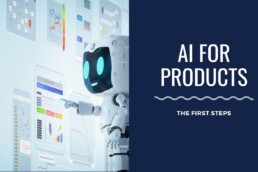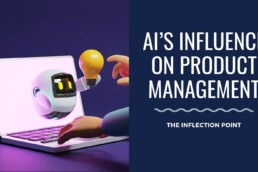The continuous advantages of Artificial Intelligence (AI) are fundamentally reshaping product strategy and management. Today, AI is no longer a supplemental technology—it’s quickly becoming essential in the design and evolution of competitive products. As AI becomes more accessible and impactful, product managers must adapt their methodologies and align their thinking with an AI-first approach.
While many might initially focus on mastering the technical intricacies of AI, such as complex algorithms and data modeling, this approach can delay immediate value creation. Instead, product leaders should first understand AI’s strategic possibilities—where and how it can most significantly impact their existing products. This practical approach fosters immediate impact and facilitates an ongoing, incremental acquisition of technical skills and knowledge as the technology matures.
This article presents a structured guide for identifying tangible AI opportunities within your products. This guide will allow you to lead confidently and strategically in today’s AI-first world.
Table of Contents
ToggleFrom Technical Mastery to Strategic Opportunity Identification
Traditionally, adopting a new technology often meant spending significant upfront resources mastering its technical complexities. While thorough technical understanding can be advantageous, it may also be a barrier, delaying tangible business outcomes.
A more strategic and agile approach encourages product managers to:
- Understand AI’s Capabilities: Clearly articulate what AI can accomplish for your product.
- Identify AI Opportunities: Systematically find areas to integrate proven AI capabilities into your product.
- Implement Incrementally: Follow a step-by-step deployment strategy, validating impact at each stage.
- Acquire AI Skills Progressively: Gradually build your AI knowledge base in parallel with practical application.
Identifying AI Capabilities: A Proven Framework
Leveraging AI effectively involves recognizing existing capabilities and aligning them with product objectives. Here’s a straightforward framework to identify immediate AI opportunities within your product suite.
1. Personalization and Recommendations
Successful examples such as Netflix, Amazon, and Spotify demonstrate that AI-driven personalization profoundly impacts user engagement and loyalty.
- Netflix leverages AI to provide personalized viewing recommendations, with approximately 75% of content viewed driven directly by recommendation engines (Source: Netflix Technology Blog).
- Amazon’s recommendation engine accounts for nearly 35% of total consumer purchases, significantly influencing customer behaviors (Source: McKinsey & Company).
Evaluate this capability for your products with these questions:
- Do customers regularly interact with your product or service?
- Can you collect adequate data on user behaviors and preferences?
- Could personalized recommendations significantly enhance user engagement or conversions?
If yes, personalization presents a robust AI advancement opportunity.
2. Predictions: Enhanced Forecasting and Decision-making
Powered by AI, predictive analytics allows businesses to foresee future events using historical data, resulting in strategic enhancements such as optimized inventory management and proactive customer engagement.
Use cases include:
- Predicting consumer purchasing trends, helping retail companies manage inventory effectively and reduce costs.
- Estimating customer churn probability, enabling companies to enhance customer retention strategies proactively.
- Anticipating workforce and supply-chain trends and disruptions, thus improving operational decisions.
Key evaluation criteria:
- Does your product or workflow heavily utilize historical or real-time data sets?
- Would accurate predictions significantly enhance strategic decisions and customer experiences?
- Could predictive insights save costs and resources or improve operational efficiency?
If your answer is affirmative, predictive analytics offers a prime opportunity for AI-driven enhancements.
3. Generative AI Capabilities: Scaling Content Creation
Generative AI has captured the industry’s imagination because it accelerates and automates content production at unprecedented levels. ChatGPT (for text), Midjourney, and DALL-E (for images) showcase generative AI’s scalability and productivity benefits.
Practical applications include:
- Scalable textual content: marketing copy, emails, product descriptions.
- Image and video generation for promotional campaigns.
- AI-driven voice and chatbot interactions vastly improve customer service and interaction experiences.
Evaluate generative AI opportunities by asking:
- Does your product continuously or frequently require fresh, customized, or creative content?
- Is repetitive content generation consuming significant human resources?
- Would automated, personalized content greatly enhance user experiences?
Generative AI is a high-impact, productivity-multiplying opportunity worth exploring.
4. Automation: Boosting Productivity and Efficiency
AI-driven automation can significantly optimize your operations by taking over repetitive, time-consuming, or error-prone tasks. Automation in this area allows teams to focus on higher-value work and innovation.
Common areas include:
- Market research and customer segmentation automation, reducing response times and increasing accuracy.
- Escalating customer service issues, sorting and categorizing user feedback intelligently and quickly.
- Automating administrative and routine operational workflows.
Evaluate this opportunity by exploring these considerations:
- Are there repetitive tasks within your workflow that could be categorized and streamlined?
- Would automating these processes enhance efficiency significantly and also reduce human errors?
- Could AI automation lead to a measurable improvement in service quality or customer satisfaction?
Automation, powered by AI, presents clear ROI benefits, efficiency gains, and valuable time savings.
Embracing a Continuous Learning Mindset
By incrementally integrating AI capabilities into your products, you naturally acquire insights and learn practical skills aligned directly with strategic priorities. This iterative, opportunity-driven learning approach reduces overwhelm, connects learning directly to business outcomes, and ensures that technical skills grow alongside tangible product advancements.
As your AI capabilities evolve, your understanding of opportunities and technologies will progressively deepen, keeping you at the cutting edge of product leadership.
Final Thoughts: Setting Your Product Up for AI Success
Successfully navigating the AI-first product management landscape requires awareness of practical capabilities, pragmatic identification of opportunities, and methodical implementation of AI-driven advancements. Supporting these endeavors with continuous learning, backed by data and effective industry practices, is essential for sustainable growth and competitive advantage.
Rather than being intimidated by AI complexity, product leaders can focus on practical value creation by smartly integrating industry-proven AI capabilities step-by-step. Doing so significantly enhances their product and team and ultimately position their business to thrive in an increasingly AI-oriented marketplace.



